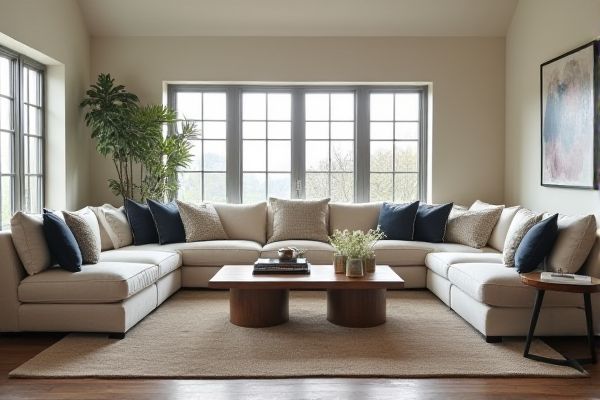
Built-in banquettes maximize space efficiency and provide a sleek, permanent seating solution ideal for dining or cozy nooks, while sectional sofas offer versatile, movable comfort perfect for living rooms and lounging areas. Explore the rest of this article to determine which seating option best suits your home's style and functionality.
Table of Comparison
| Feature | Built-in Banquette | Sectional Sofa |
|---|---|---|
| Space Efficiency | Optimizes corner and wall space, perfect for small areas | Requires more floor space, less efficient in tight rooms |
| Customization | Custom-built to fit specific dimensions and style | Available in modular sections, with limited customization |
| Comfort | Firm seating with fixed cushions | Generous cushions and deep seating for maximum comfort |
| Storage | Often includes under-seat storage options | Storage options are rare and usually separate |
| Installation | Permanent fixture requiring professional installation | Freestanding and easy to move or rearrange |
| Maintenance | Integrated design can make cleaning harder | Removable cushions and covers simplify cleaning |
| Aesthetic Appeal | Custom-tailored to match interior decor seamlessly | Variety of styles and fabrics but may lack uniqueness |
Introduction to Banquettes and Sectionals
Built-in banquettes maximize your space with custom seating integrated into walls or corners, providing a cozy and permanent dining or lounging area. Sectional sofas offer flexible, modular seating that can be rearranged to fit various room layouts and accommodate more people. Choosing between a banquette and a sectional depends on your room's size, style, and function preferences.
Space Efficiency: Banquette vs Sectional
Built-in banquettes maximize space efficiency by fitting snugly into corners or along walls, offering more seating with less floor area compared to sectional sofas. Sectionals provide flexible seating arrangements but often require larger footprints, which can overwhelm small rooms. Your choice depends on optimizing available space while maintaining comfort and style in your living area.
Aesthetic and Style Considerations
Built-in banquettes create a sleek, custom look that maximizes space and integrates seamlessly with architectural elements, ideal for modern or minimalist interiors. Sectional sofas offer versatile arrangements and come in a variety of fabrics and designs, making them adaptable to both traditional and contemporary styles. While banquettes emphasize streamlined elegance and fixed seating, sectionals provide flexibility and a cozy, inviting atmosphere.
Comfort and Functionality
Built-in banquettes provide space-saving comfort with customized seating and integrated storage options that enhance room functionality, making them ideal for cozy dining or reading nooks. Sectional sofas offer versatile comfort with adjustable configurations, ample seating, and modular pieces tailored to accommodate larger gatherings and provide relaxation flexibility. Your choice depends on whether you prioritize tailored built-in efficiency or the adaptable, plush comfort of a sectional sofa.
Storage Potential: Built-In Options
Built-in banquettes offer superior storage potential with custom-designed compartments underneath the seating, maximizing space efficiency in your room. Unlike sectional sofas, which typically provide limited or no storage, built-in banquettes can incorporate drawers or cabinets tailored to your specific needs. This functionality makes built-in banquettes an ideal choice for those seeking to optimize every inch of their living area.
Customization and Design Flexibility
Built-in banquettes offer unparalleled customization by seamlessly integrating into your room's architecture, allowing for tailored dimensions, materials, and storage options that optimize space utilization. Sectional sofas provide design flexibility through modular components that can be rearranged to suit varying layouts and accommodate different seating needs. Your choice depends on whether you prioritize a fixed, personalized installation or adaptable, reconfigurable seating arrangements.
Durability and Maintenance
Built-in banquettes are typically constructed with sturdy materials like hardwood frames and durable upholstery designed to withstand heavy, frequent use, resulting in enhanced longevity. Sectional sofas often feature modular cushions and fabric coverings that may require regular cleaning and potential replacement of parts over time, making maintenance more intensive. The fixed nature of banquettes reduces wear from movement, while sectional sofas offer flexibility but demand more upkeep to retain durability.
Cost Comparison: Investment Breakdown
Built-in banquettes generally require higher upfront costs due to custom design, materials, and installation fees, making them a significant investment in both craftsmanship and space utilization. Sectional sofas offer a more flexible and often less expensive option, with prices varying widely based on fabric, size, and brand but typically avoiding costly permanent modifications. The cost breakdown reveals that built-in banquettes add value through durability and tailored fit, while sectional sofas prioritize affordability and ease of replacement or rearrangement.
Best Room Applications
Built-in banquettes are ideal for maximizing space in kitchens and dining nooks, offering custom seating that fits securely against walls and under windows, perfect for small or irregularly shaped rooms. Sectional sofas excel in large living rooms and open-concept spaces, providing versatile seating arrangements that can be easily reconfigured to accommodate gatherings and multiple seating needs. Choosing between the two depends on room size and function, with built-in banquettes enhancing intimate dining areas and sectionals supporting expansive social environments.
Choosing What’s Right for Your Space
Built-in banquettes maximize space efficiency by fitting seamlessly into corners or along walls, providing customized seating that often includes integrated storage. Sectional sofas offer versatile arrangements and comfort, ideal for larger living areas or open floor plans where flexibility is key. Your choice depends on the room's layout, size, and how you prioritize functionality versus design adaptability.
 homyna.com
homyna.com